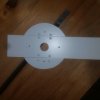I have finally tested my cameras locally and am ready to install them! I want to mount them on my vinyl soffit. I know a soffit is a bit high up but the rest of my house is brick so I don't want to drill into it. I bought junction boxes like below (for example, i have several boxes depending on the cam).
EmpireTech Water-Proof Junction Box Bracket PFA130-E White - - Amazon.com
I was surprised that there is no hole to feed the wires through the top of the mount, it looks like you have to put in the wire from the side of the box (see 3rd pic in my link). So I am supposed to mount the box then drill a small hole in the soffit to feed the wire down and into the side of the box? If so that doesn't seem very clean looking to have a small wire showing, so that's why I am asking.
My plan is to run my Cat6 from my basement to attic, it will terminate to Ubiquiti Flex Switches (powered by POE++) and then go out to the cameras. That will allow me to have shorter runs to the cameras.
1) Is there a recommended "How To" video for soffit installs? I have a Kline tools 30ft fishing tape, do you think that's sufficient, or will I need the "fiberglass fishing poles" (Length is fine, i'm talking more about do I have the right tool for the job?)
2) Would it be a good idea to cut some wood boards slightly shorter than the vinyl soffits and put them up in the soffit and mount the junction boxes/cameras to that? I saw a video once of someone cutting aluminum strips to put in the soffit but those don't seem that sturdy. These cameras are fairly heavy.
3) Anything else to be aware of or watch out for? (ex: I already installed my MicroSD cards, if i had mounted first that could have been a pain).
Thanks!
EmpireTech Water-Proof Junction Box Bracket PFA130-E White - - Amazon.com
I was surprised that there is no hole to feed the wires through the top of the mount, it looks like you have to put in the wire from the side of the box (see 3rd pic in my link). So I am supposed to mount the box then drill a small hole in the soffit to feed the wire down and into the side of the box? If so that doesn't seem very clean looking to have a small wire showing, so that's why I am asking.
My plan is to run my Cat6 from my basement to attic, it will terminate to Ubiquiti Flex Switches (powered by POE++) and then go out to the cameras. That will allow me to have shorter runs to the cameras.
1) Is there a recommended "How To" video for soffit installs? I have a Kline tools 30ft fishing tape, do you think that's sufficient, or will I need the "fiberglass fishing poles" (Length is fine, i'm talking more about do I have the right tool for the job?)
2) Would it be a good idea to cut some wood boards slightly shorter than the vinyl soffits and put them up in the soffit and mount the junction boxes/cameras to that? I saw a video once of someone cutting aluminum strips to put in the soffit but those don't seem that sturdy. These cameras are fairly heavy.
3) Anything else to be aware of or watch out for? (ex: I already installed my MicroSD cards, if i had mounted first that could have been a pain).
Thanks!
As an Amazon Associate IPCamTalk earns from qualifying purchases.


